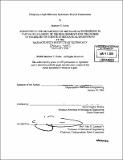Designing a high-efficiency hydrostatic bicycle transmission
Author(s)
Socks, Matthew T. (Matthew Tristram)
DownloadFull printable version (2.420Mb)
Other Contributors
Massachusetts Institute of Technology. Dept. of Mechanical Engineering.
Advisor
David Gordon Wilson.
Terms of use
Metadata
Show full item recordAbstract
Hydrostatic bicycle drives use a working fluid instead of the common roller-chain to transmit power to the drive wheel. These transmissions are typically considered too inefficient for human power applications. An experiment consisting of a very simple hydrostatic drive was designed and built in an attempt to measure the efficiency of these devices at approximate cycling speeds. A theoretical model was also developed to help predict losses using a wider range of operational parameters. Due to shortcomings of the experiment design, the measured efficiencies were on the order of 60% - considerably lower than those theoretically possible. Although the experimental results are of limited value, this study highlights the importance of minimizing side-loading on hydraulic cylinder piston-rods during low-speed, low-pressure operation. The research is used to suggest several design features which may aid in continued attempts to develop a highly efficient hydrostatic transmission.
Description
Thesis (S.B.)--Massachusetts Institute of Technology, Dept. of Mechanical Engineering, 2006. Includes bibliographical references (leaf 24).
Date issued
2006Department
Massachusetts Institute of Technology. Department of Mechanical EngineeringPublisher
Massachusetts Institute of Technology
Keywords
Mechanical Engineering.